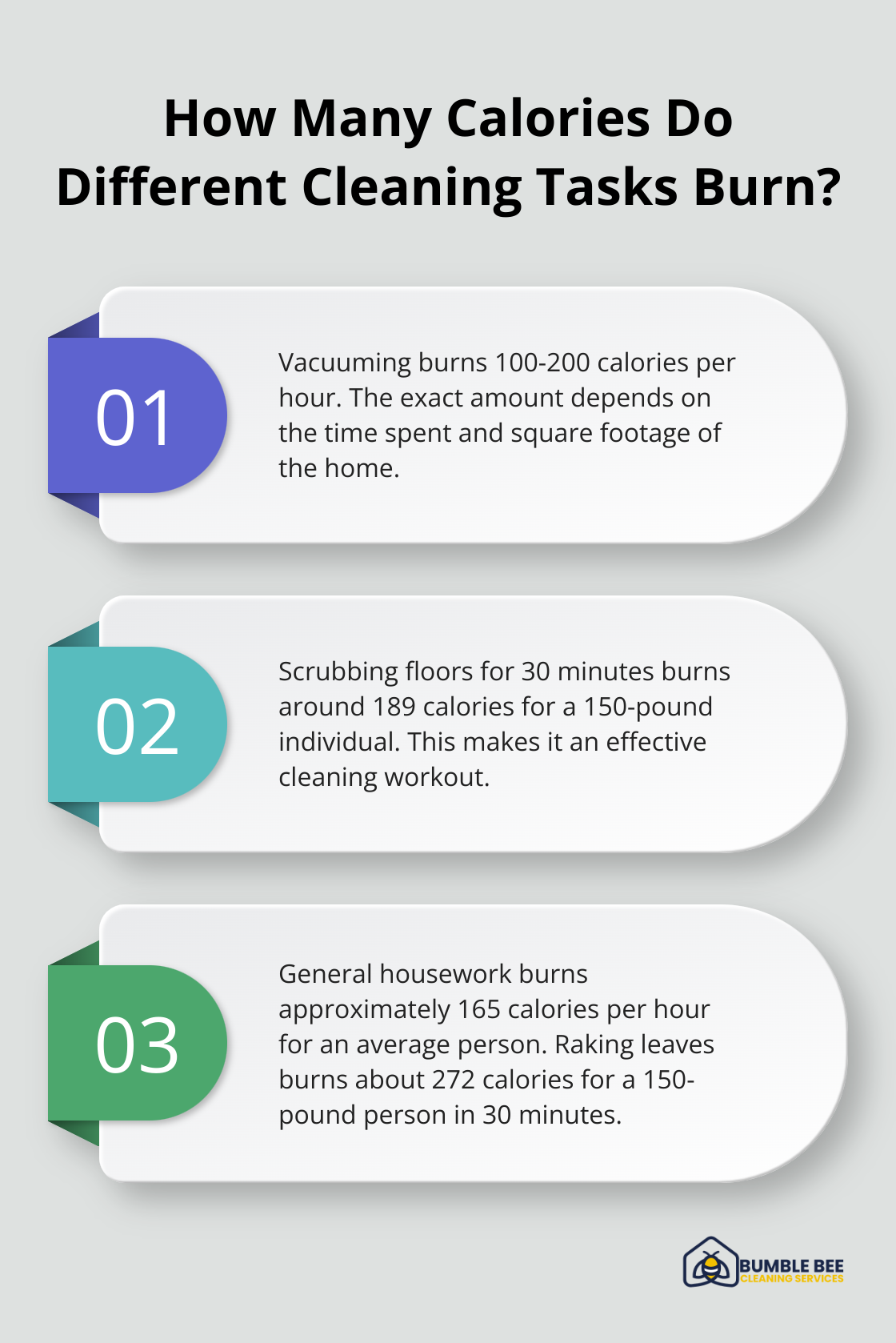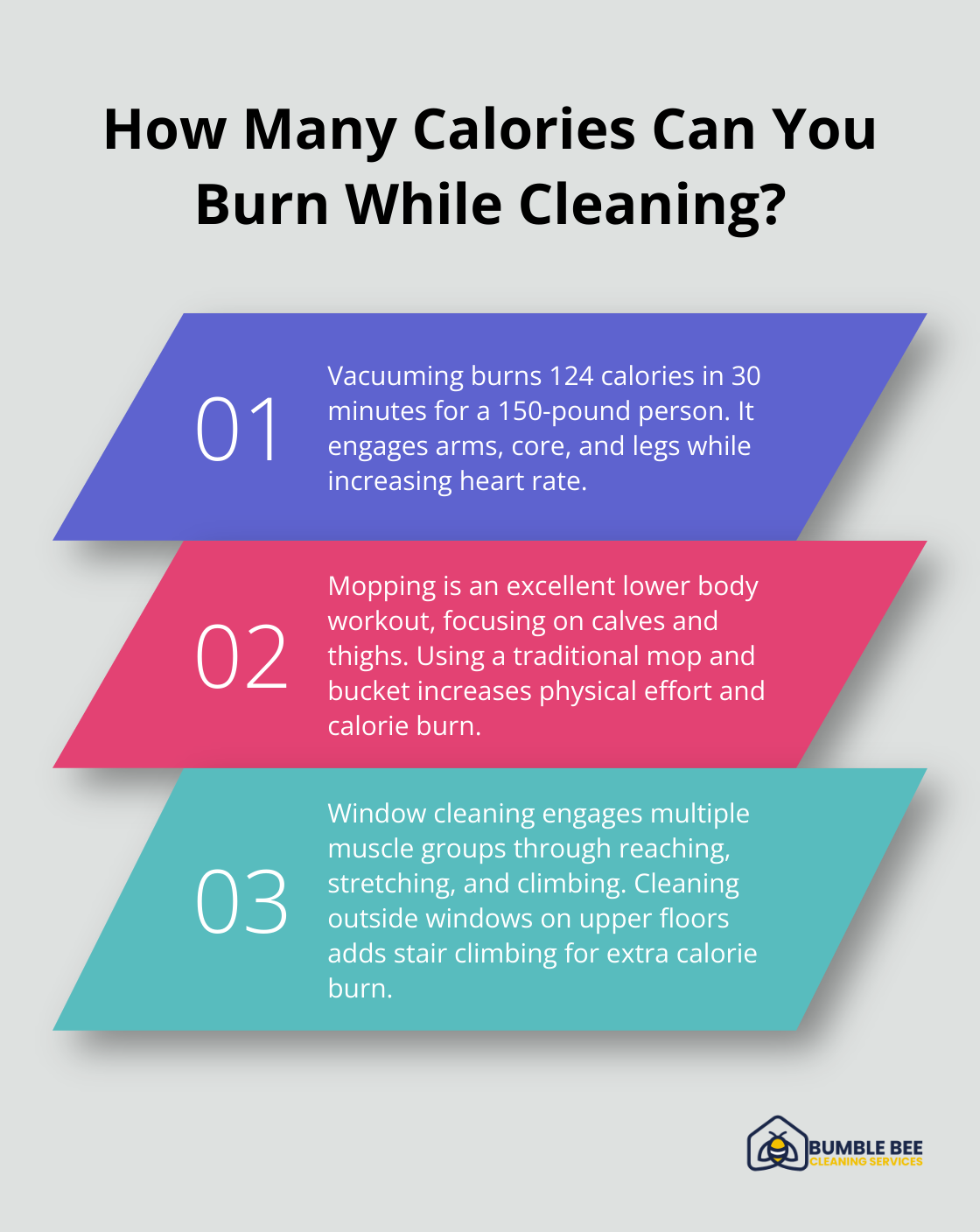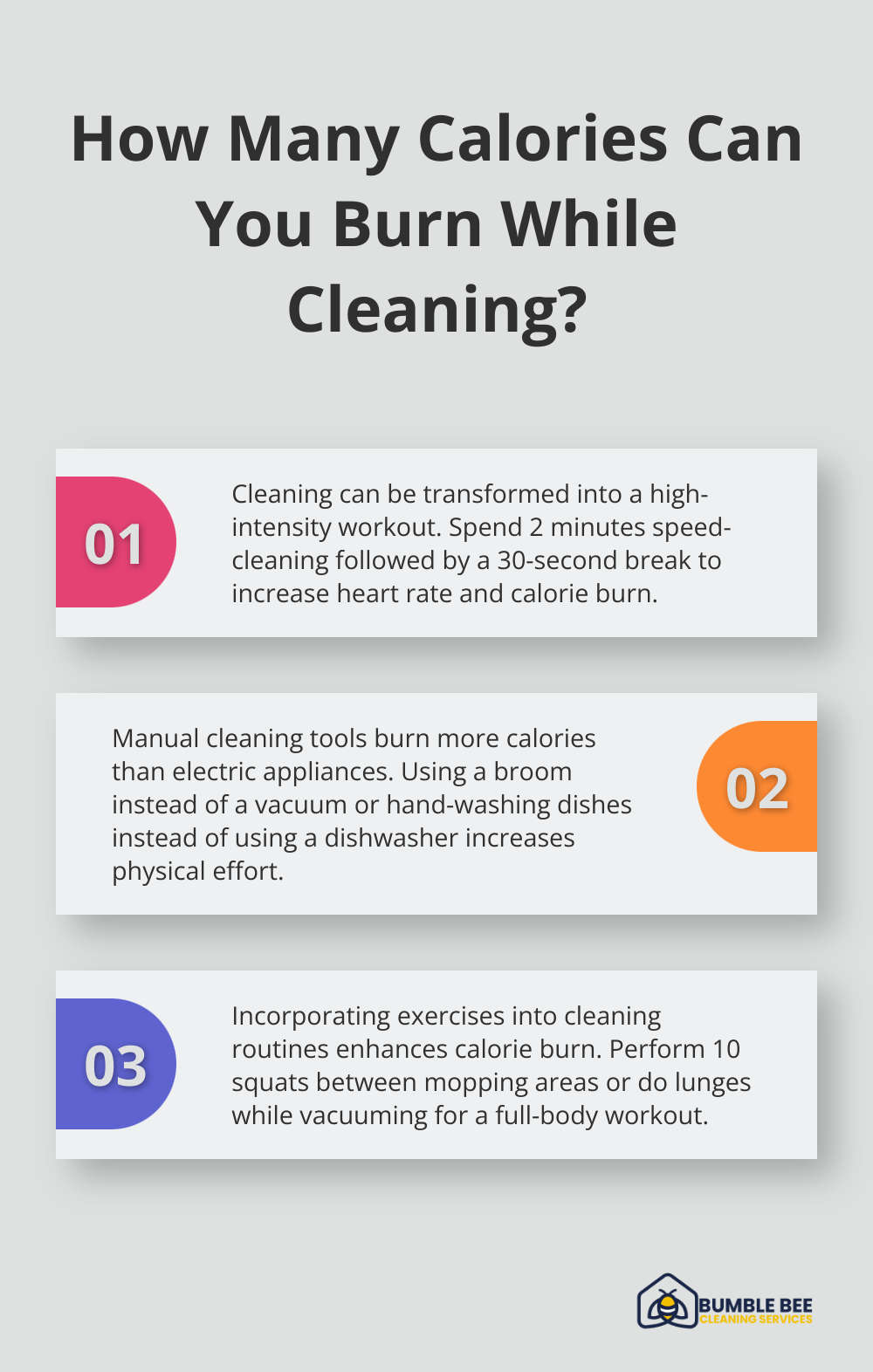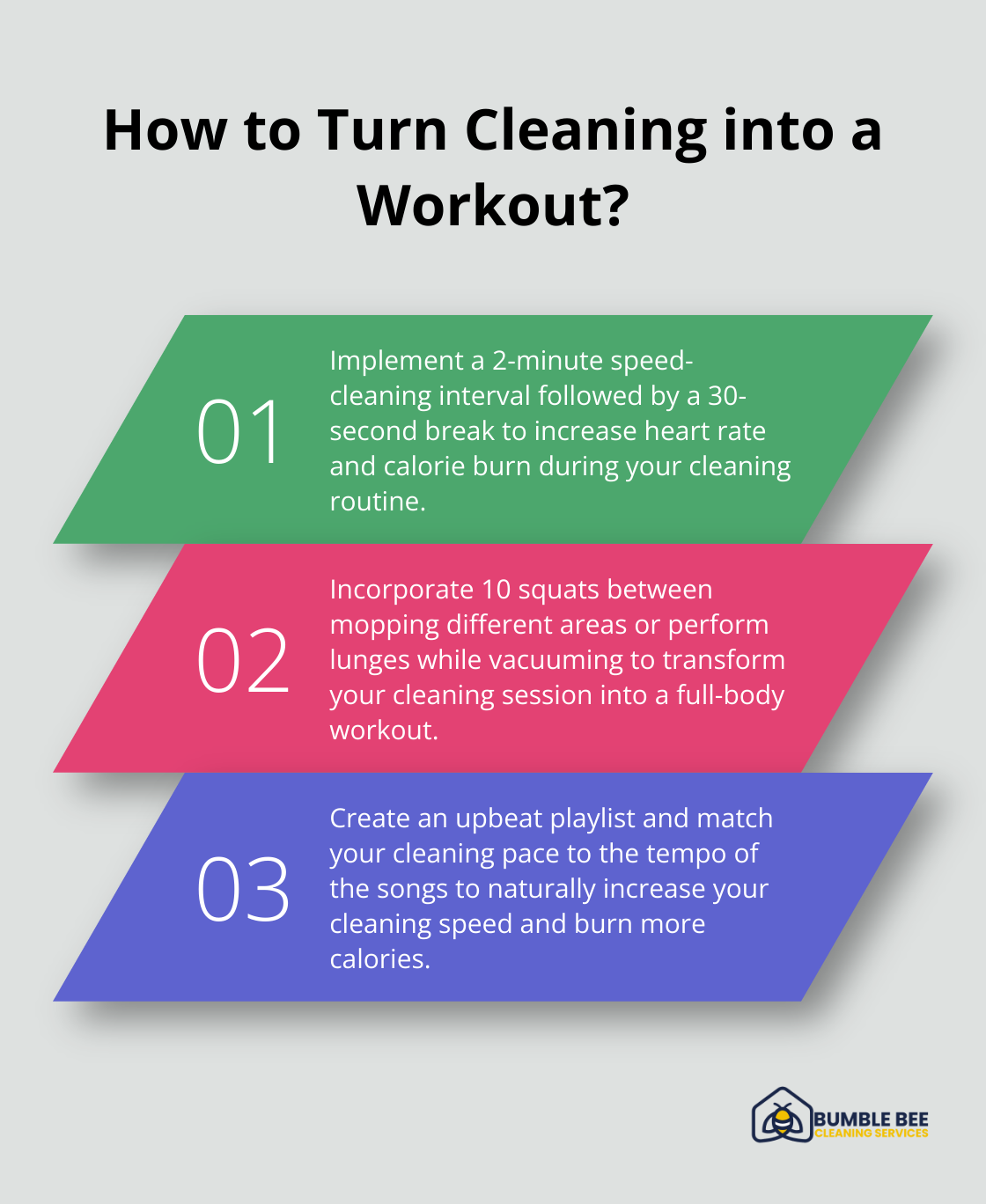At Bumble Bee Cleaning Services, we often get asked about the health benefits of cleaning. Many people wonder about the calories burned during house cleaning.
Housework can be a surprisingly effective way to stay active and burn calories. In this post, we’ll explore how different cleaning tasks contribute to calorie burn and how you can maximize your energy expenditure while tidying up your home.
Table of Contents:
What Impacts Calorie Burn While Cleaning?
Body Composition: A Key Factor
Your body weight and composition significantly influence calorie burn during cleaning activities. Heavier individuals typically expend more energy. For example, vacuuming will burn roughly 100-200 calories in an hour, depending on the time and square footage of the home.
Intensity Amplifies Results
The vigor of your cleaning activities directly affects energy expenditure. Vigorous scrubbing, rapid movements, and tackling demanding tasks (like moving furniture) can substantially increase calorie burn. Scrubbing floors for 30 minutes, for instance, burns around 189 calories for a 150-pound individual, making it an effective cleaning workout.
Time: The Calorie Multiplier
The duration of your cleaning session plays a crucial role in total calorie burn. A full hour of general housework burns approximately 165 calories for an average person. To boost your calorie burn, consider splitting your cleaning routine into multiple sessions throughout the day or dedicating larger blocks of time to more intensive tasks.
Task-Specific Energy Expenditure
Different cleaning tasks burn varying amounts of calories. Raking leaves burns about 272 calories for a 150-pound person in 30 minutes, while washing windows for the same duration burns roughly 153 calories (for a 150-pound person). Incorporating a mix of tasks in your cleaning routine provides a well-rounded workout and maximizes calorie burn.

As we explore the calorie-burning potential of specific cleaning activities, you’ll discover how to transform your housework into an effective fitness routine. Let’s examine some common cleaning tasks and their associated calorie burn in the next section.
Calorie Burn in Common Cleaning Tasks
Cleaning your home isn’t just about maintaining a tidy living space; it’s also an excellent way to stay active and burn calories. Many people are surprised to learn how effective their cleaning routines can be for their fitness goals. Let’s explore the calorie-burning potential of some common cleaning activities.
Vacuuming: A Cardio Workout
Vacuuming is one of the most common household chores and a great way to increase your heart rate. For a 150-pound person, vacuuming burns 124 calories in 30 minutes. This activity engages your arms, core, and legs as you push and pull the vacuum across different surfaces. To maximize calorie burn, maintain a brisk pace and use proper form by engaging your core muscles.
Mopping: Lower Body Focus
Mopping is an excellent lower-body workout that can burn calories. This task engages your leg muscles, particularly your calves and thighs, as you move back and forth across the floor. To increase the intensity, use a traditional mop and bucket instead of a steam mop, as this requires more physical effort.
Dusting: Upper Body Toner
While dusting might seem like a light activity, it still contributes to your daily calorie burn. This task primarily engages your arms and shoulders, especially when reaching high shelves or tackling ceiling fans. To boost the calorie burn, incorporate some lunges or squats as you move from one area to another.
Window Cleaning: Full-Body Engagement
Window cleaning is a surprisingly effective workout. This task requires reaching, stretching, and sometimes climbing, which engages multiple muscle groups. For an added challenge, clean the outside of windows on upper floors (safely, of course) to incorporate stair climbing into your routine.
Scrubbing Bathrooms: High-Intensity Cleaning
Bathroom cleaning, particularly scrubbing, is one of the most calorie-intensive household chores. The combination of scrubbing, reaching, and often squatting or kneeling makes this a full-body workout. To maximize the benefits, maintain a vigorous pace and alternate between using your left and right hands to ensure balanced muscle engagement.

It’s important to note that calorie estimates can vary based on individual factors such as weight, intensity of effort, and specific cleaning techniques. However, the key takeaway is that regular household cleaning can significantly contribute to your daily physical activity and calorie expenditure.
Now that we’ve explored the calorie-burning potential of common cleaning tasks, let’s look at how you can maximize your energy expenditure while tidying up your home.
Supercharge Your Cleaning Routine
Boost Intensity with Cleaning Intervals
Transform your cleaning routine into a high-intensity workout. Spend 2 minutes speed-cleaning a room, then take a 30-second break. Repeat this pattern throughout your cleaning session. This approach will significantly increase your heart rate and calorie burn.
Mix Cleaning with Exercise
Blend cleaning tasks with bodyweight exercises to amplify your workout. Do 10 squats between mopping different areas of the floor, or perform lunges as you vacuum. Add push-ups against the kitchen counter while waiting for the sink to fill. These simple additions will turn a regular cleaning session into a full-body workout.
Opt for Manual Tools
Use manual tools instead of electric appliances when possible. A broom instead of a vacuum or a mop instead of a steam cleaner requires more physical effort, leading to increased calorie burn. Hand-washing dishes instead of using a dishwasher can be an effective way to burn calories while cleaning.
Clean to the Beat
Music can motivate you to clean faster. Create an upbeat playlist to clean to, matching your movements to the tempo of the songs. Faster music will naturally increase your cleaning pace, resulting in more calories burned (and a more enjoyable process).
Take the Stairs
If you live in a multi-story home, use the stairs frequently during your cleaning routine. Climbing stairs can be an effective way to burn calories. Even if you only spend a few minutes going up and down, it adds up over the course of your cleaning session.

Final Thoughts
House cleaning offers more than just a tidy living space; it provides an excellent opportunity to increase physical activity and burn calories. The calories burned during house cleaning can contribute significantly to your daily energy expenditure, engaging various muscle groups and improving overall fitness. Regular cleaning not only maintains a clean home but also serves as a consistent form of exercise, potentially aiding in weight management and cardiovascular health.

Approaching cleaning as a workout can transform your perspective on household chores. You can maximize your efforts through high-intensity cleaning bursts, combine tasks with bodyweight exercises, and maintain a brisk pace to turn your cleaning routine into an effective workout. Every movement counts towards your daily activity goals, making cleaning a valuable addition to your fitness regimen.
At Bumble Bee Cleaning Services, we understand the importance of a clean and healthy living environment. Our professional cleaning services save you time and allow you to focus on other aspects of your life. For those times when you choose to clean yourself, embrace the physical benefits that come with it (and enjoy the dual reward of a spotless home and a healthier lifestyle).
